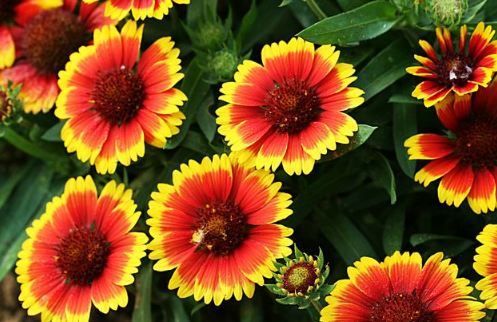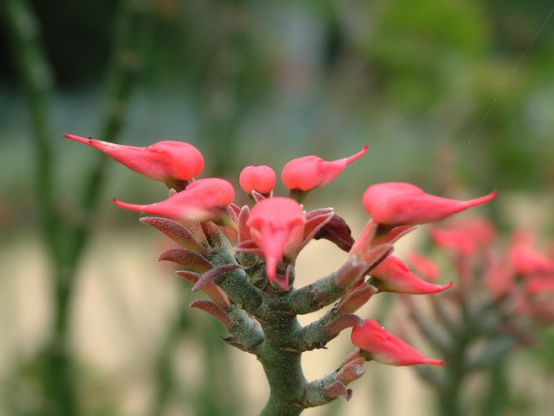Matters needing attention in the Culture of Chrysanthemum morifolium
Upper basin
When the seedlings of the chrysanthemum are to be transplanted into the pot, we should pay attention to putting some broken tiles and bricks at the bottom of the flowerpot to make a filter layer, and then sprinkle some rotten fertilizer as the base fertilizer, and then put a layer of soil on the base fertilizer. After that, you can plant the plant, water it once after planting, and water it thoroughly once, and then put it in a shady environment for some time, and then you can carry out normal maintenance.

Pick the heart and trim
Pruning is very important to the growth of Chrysanthemum morifolium. When the seedlings of Chrysanthemum morifolium grow to more than 6 leaves, removing the top tip can promote the branching of the plant, and then picking the heart again in the growth process can shape the ideal plant type and promote more flowering.
I hope that after reading this article, you can have a better understanding of the chrysanthemum, and then will maintain a very beautiful chrysanthemum.
Culture methods and matters needing attention of Chrysanthemum morifolium
Culture methods of Chrysanthemum morifolium 1. Adapt to the environment
Tianren chrysanthemum is resistant to drought and heat, is not cold-resistant, likes sunshine, and is also resistant to semi-shade, so it is suitable for loose soil with good drainage. It is wind-resistant, moisture-resistant, tough and drought-resistant. It is a good wind-proof and sand-fixing plant.
2. Soil requirements
Planting Chrysanthemum morifolium, you need to choose suitable soil, generally need to choose good drainage, loose soil, but be careful not to choose acidic soil, will make the plant grow poorly.
3. Light and temperature
Chrysanthemum likes high temperature and sunny growth environment, can withstand heat, slightly less cold, the suitable temperature for growth is between 15 ℃ and 35 ℃. Plenty of sunshine is required, but it can withstand semi-overcast.
4. Sufficient amount of water
The demand for watering of Chrysanthemum morifolium is more and less. It is more resistant to drought and avoid rain, but it also needs to maintain a certain degree of air humidity. In general, chrysanthemum should be watered and fertilized for a small number of times.
5. the amount of fertilizer is sufficient.
In the cultivation measures, Chrysanthemum morifolium should pay attention to apply sufficient base fertilizer, spray flower fertilizer, open ditches to reduce stains, pick the heart to promote the development of residual flowers, and so on. During the growth period, fertilize as early as possible, apply more phosphate fertilizer and potassium fertilizer, keep the plant dry after fertilization, and properly control water and fertilizer during flowering.
Matters needing attention in chrysanthemum culture 1. Matters needing attention in pots
When potting the seedlings of Chrysanthemum morifolium, put shredded tiles or coarse sand at the bottom of the flowerpot to make a filter layer, sprinkle some rotten fertilizer as base fertilizer, put a layer of soil on the base fertilizer, and finally put the plant. After potting, water the flowerpot once and keep it in a shady environment for a period of time.
2. Matters relating to the management of florescence
It is necessary to keep the matrix moist during the flowering period of chrysanthemum, and the lack of water will shorten the florescence. Especially in the full bloom, timely targeted replenishment of water, to keep the perennial root Chrysanthemum moist.
3. Heart-picking and pruning
Pruning is very important to the growth of Chrysanthemum morifolium. When the seedlings of Chrysanthemum morifolium grow to more than 6 leaves, removing the top tip can promote the branching of the plant, and then pick the heart once in the growth process, which can shape the ideal plant type and promote more flowering.
Culture methods and matters needing attention of Chrysanthemum morifolium
Latin name Gaillardia Pulchella Foug.
Don't call it tiger skin chrysanthemum, tiger skin chrysanthemum
Binomial Gaillardia Pulchella
The plant kingdom.
Phylum angiosperm
Dicotyledonous class
Citrus pedunculata
Compositae
Belong to the genus Chrysanthemum
Grow chrysanthemum
The distribution area is native to North America and is widely cultivated in central and southern China.
Gaillardia pulchella Foug., also known as tiger skin chrysanthemum, tiger skin chrysanthemum (Shanghai). Native to North America, it is widely cultivated in central and southern China. Resistant to drought and heat, not cold, like sunshine, but also resistant to semi-shade, it is suitable for loose soil with good drainage. It is wind-resistant, moisture-resistant, tough and drought-resistant, so it is a good wind-proof and sand-fixing plant. The chrysanthemum is the state flower of Oklahoma and the county flower of Penghu County, Taiwan.
1. Morphological characteristics.
Annual herbs. The plant is about 20~60cm tall and the whole plant is pilose. Leaves alternate, lanceolate, rectangular-rounded to spatulate, entire or basal leaves pinnatifid. Petaloid, ligulate flower apex yellow, base brownish purple. Flowering in summer and autumn. The cultivated variety Chrysanthemum cornflower, ligulate flowers and even inflorescence basin-shaped tubular flowers have developed into funnel-shaped flowers, with large flowers and safflower varieties. The flowering period is from July to October, and the fruit ripening stage is from August to October. The flower of chrysanthemum belongs to "head inflorescence", "a flower" is actually "a bunch of flowers", because it contains many tongue-shaped flowers and tube-shaped flowers. The outer tongue-shaped flowers are colorful, like a tarmac that attracts insects; the tube-shaped flowers in the middle look like small balls, and when the tongue-shaped flowers wither, this part develops into fruit clusters, and the seeds inside float with the wind and fall to the ground to grow. In addition, the tongue-shaped flowers of some chrysanthemums grow into tubular, seemingly curved trumpets; some varieties of chrysanthemums have bright yellow flowers with a unique rhyme; and the leaves and pilose of chrysanthemums are also worth observing.
2. Habit distribution
Sexual preference for high temperature, dry and sunny environment. Its salt tolerance is good, strong wind resistance, drought resistance is good, cold resistance is good, negative tolerance is poor.
Originated in North America, resistant to drought and heat, not cold, like sunshine, but also resistant to semi-shade, it is suitable for loose soil with good drainage. It is wind-resistant, moisture-resistant, tough and drought-resistant. It is a good wind-proof and sand-fixing plant. In acid soil, it is not only difficult to obtain strong seedlings, but also wither the lower leaves in midsummer, fertilizer should be applied early for rapid growth, and the ratio of phosphorus and potassium should be higher.
3. Cultivation techniques.
Reproduction method
(1) sowing: often sowing in summer, disinfecting the substrate used for sowing, the best way is to put it in a pan and stir-fry it so that any diseases and insects can be scalded to death. Soak the seeds in warm hot water (the temperature is about the same as facial wash) for 3 to 10 hours until the seeds absorb water and expand. For common seeds that germinate easily, this work does not have to be done. For tiny seeds that are difficult to pick up with hands or other tools, wet one end of the toothpick with water, stick the seeds one by one on the surface of the matrix, cover the substrate 1 cm thick, and then put the seeding pot into the water. The depth of the water is 1 stroke 2 feet 2 tap 3 of the height of the flowerpot, allowing the water to soak up slowly. For larger seeds that can be picked up by hand or other tools, put the seeds directly into the substrate and order them at a distance of 3 × 3 cm. After sowing, the substrate was covered, and the thickness of the cover was 2-3 times that of the seed. After sowing, the sowing matrix can be wet with sprayer and fine hole shower, and then drenched later when the potted soil is slightly dry, but still pay attention not to watering too hard, so as not to wash the seeds up; management after sowing: after the seedlings are unearthed, the film should be opened in time, and let the seedlings receive the sun's light before 9:30 every morning or after 3:30 in the afternoon, otherwise the seedlings will grow very weakly. After most of the seeds come out, they need to plant seedlings properly: pull out the diseased and unhealthy seedlings, so that the seedlings left behind have a certain space between each other; when most of the seedlings grow 3 or more leaves, they can be transplanted into the pot.
- Prev

Propagation methods of Chrysanthemum morifolium
Cutting propagation is also a relatively simple propagation method. The material to be selected for cutting is called cutting. cuttings usually choose top tips that grow well and are free from diseases and insect pests. The cutting temperature should be kept between 18 ℃ and 25 ℃. The cutting of cuttings should be disinfected. If the temperature is too high, it is easy to cause infection.
- Next

Matters needing attention in sowing cardinals
Seed selection before sowing, we must first select the seed, the seed selection is very important, because the quality of the seed is directly related to the success of our sowing. 1. It is best to choose the seeds harvested in this year. Because the longer the seed is preserved, the lower its germination rate is.
Related
- Fuxing push coffee new agricultural production and marketing class: lack of small-scale processing plants
- Jujube rice field leisure farm deep ploughing Yilan for five years to create a space for organic food and play
- Nongyu Farm-A trial of organic papaya for brave women with advanced technology
- Four points for attention in the prevention and control of diseases and insect pests of edible fungi
- How to add nutrient solution to Edible Fungi
- Is there any good way to control edible fungus mites?
- Open Inoculation Technology of Edible Fungi
- Is there any clever way to use fertilizer for edible fungus in winter?
- What agents are used to kill the pathogens of edible fungi in the mushroom shed?
- Rapid drying of Edible Fungi

